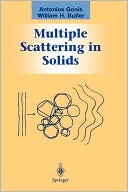

 |

|

The average rating for Multiple Scattering in Solids based on 2 reviews is 3 stars.
Review # 1 was written on 2011-06-26 00:00:00 Milo Milic Milo MilicIn Quantum Ring Theory Wladimir Guglinski presents a radical new theory concerning the fundamental nature of physics. Hailed as a intriguing theorist by Dr. Eugene Mallove, president of the New Energy Foundation, Guglinski argues that the current understanding of physics does not put forth an accurate model of the world. Instead, Guglinski argues that we must once again consider the "aether," a notion originally put forth by Greek philosophers. By considering the nature of "aether" and its role in physical processes, Guglinski is able to put forth a theory that reconciles Quantum Physics with the Theory of Relativity. To date, no other physical theory is able to accord for the intraction between these two fundamental areas of physics. As part of Guglinski's new theory, the author presents a new model of the neutron. Guglinski's model of the neutron has been confirmed by contemporary physical experiments: The first one was made by Don Borghi and published in 1993 by the American Institute of Physics; the second experiment was made by Elio Conte and Maria Pieralice, subsequently published in the magazine Infinite Energy in 1999. Currently, other experiments around the world are being conducted to test the remainder of Guglinski's theoretical work. Quantum Ring Theory presents for the first time in a complete text the theoretical work of Wladimir Guglinski. In this volume cutting edge theoretical work in physics is presented; theoretical work which may ultimately change the very way we understand the world. Here is the publishers website: Quantum Ring Theory |
Review # 2 was written on 2019-06-11 00:00:00 Frederick Menkello Frederick MenkelloAfter reading three of Kragh's books (Cosmology and Controversy [1996], Conceptions of Cosmos [2006] and Higher Speculations [2011]) I decided to read one more - and I am glad I did. Whereas in the earlier mentioned books Kragh delves deeply into science and writes books of 300-400+ pages on just a few topics, Quantum Generations is a much more accessible book. In essence, it's a book about the developments in physical science in the 20th century. Written in 1997-1999, the book is a little outdated on some topics (such as cosmology), but it gives the reader a comprehensive - and comprehensible! - overview of physics. Each chapter is about 15 pages long and deals with a specific topic, which is a welcome change (in most of his other books, Kragh writes very long and dense chapters of 40+ pages long). Kragh gives detailed explanations about the scientific theories themselves, but also discusses topics such as the militarization of physics after World War II, socio-cultural attitudes towards science, the scientific method as such (and philosophy of science). The only downside of this book is that some chapters are extremely accessible, and some other chapters - especially towards the end of the book; dealing with high energy physics and grand unification theories - require much more prior knowledge about the respective topics. Kragh could have offered a little bit more background information on topics such as the discovery of new fundamental particles, the development of the weak electromagnetic theory and the gauge field theories of strong interactions. Nevertheless, this was a delightful book to read and helps tremendously to put more basic knowledge of physics in a bigger perspective. |
CAN'T FIND WHAT YOU'RE LOOKING FOR? CLICK HERE!!!